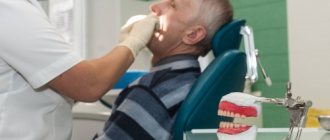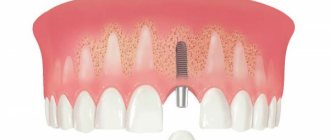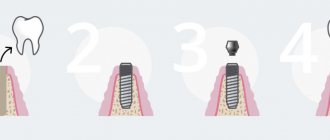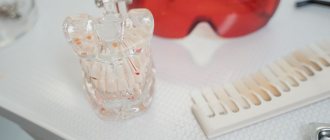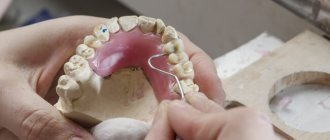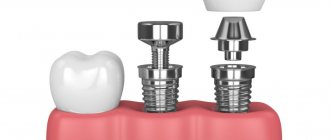Fiberglass pin is a rod consisting of an optical fiber placed in a special resin. This device is used to treat teeth after tissue damage by various diseases. The pin is installed in the root canal of the tooth to strengthen and restore the natural properties of hard tissues. This is a very effective technique that is used during endodontic treatment.
At the end of complex dental operations, tissues are significantly modified, which is characterized by a decrease in their strength characteristics. Teeth become fragile and vulnerable to all possible influences. The problem is solved by installing pins: they allow you to restore the original strength of the tissue. This is achieved by creating a monolithic structure inside the tooth, which functions properly over a long period of time.
The use of high-quality pins allows patients not to be limited to any diet, but to live a full life. The fiber optic pin can withstand heavy loads, so you can eat absolutely any food. Moreover, the unique design of the device helps to significantly reduce the process of tooth decay.
Fiberglass dental prosthetics: when and why
Restoring a tooth using a pin
Fiberglass for splinting teeth
Adhesive bridge prosthetics
Many people associate the word “fiberglass” with construction work, but not with dental treatment. At the same time, fiberglass is one of the modern materials actively used in dentistry. With its help you can solve several problems at once. For example, using a fiberglass pin, doctors restore a tooth affected by pulpitis.
Indications and contraindications for installing a fiberglass pin
The main indications for installing a pin include the following:
- the patient began to undergo endodontic treatment, but the crown of the tooth was destroyed by more than 2/3;
- presence of allergies to metal structures;
- it is necessary to depulpate the anterior teeth;
- it is necessary to strengthen the tissue after treatment;
- There is already a metal structure in the oral cavity and it is necessary to avoid the occurrence of galvanic current.
Contraindications include the presence of any diseases of the circulatory, nervous or endocrine systems. If oncology is present, a set of additional studies will be required to ensure that the procedure is possible.
In some cases, installing a post will require additional resources, for example, in the case of caries or periodontitis.
Tooth restoration using a pin
Today, fiberglass dental prosthetics is a common procedure that allows you to restore part of a tooth destroyed by caries. The pin is made of thin fibers and is inserted into the dental canal. In essence, it replenishes the functions of the root. From the inside it is filled with composite epoxy resin. This combination gives durability to the denture and completely eliminates tooth corrosion.
Fiberglass prosthetics does not expose the tooth to further destruction, unlike metal pins, since fiberglass has a high degree of flexibility. Besides this, the material has other advantages.
- Lightweight and transparent, so the fiberglass pin is invisible in the coronal part of the tooth.
- Elasticity, allowing you to evenly distribute the chewing load.
- Light transmittance.
- Easy to install.
- Does not lead to root fracture.
If you follow your doctor's recommendations, a tooth on a fiberglass post can last from 5 to 10 years.
How to install the pin
First of all, the doctor will diagnose the patient and also perform all the necessary preparatory procedures. To ensure reliable fixation, it is necessary to achieve ideal preparation of the tooth, otherwise it will simply be impossible to achieve the desired result.
At the end of the therapeutic measures, depulpation and cleansing of the canal is carried out. Let us note that Moscow clinics use modern technologies to remove the nerve, so everything is done quickly and harmlessly to the tooth root. After this, treatment with phosphoric acid occurs, both the internal cavity and the surface of the crown itself are treated.
After this, the tooth is thoroughly washed with distilled water, and then dried and re-treated with a special preparation. And only upon completion of all preparatory procedures does the process of direct installation of the pin begin.
The entire operation is performed in stages with a clear sequence of actions:
- the pre-prepared pin is degreased with a special solution (for example, acetone, alcohol or chloroform), and then covered with a double layer of bonding agent;
- A composite material is placed into the root canal, which is evenly distributed along the walls of the canal (the pin itself will be processed with the same material in the future);
- then a pin is placed inside the channel;
- The filling material hardens under the influence of special lamps.
The final stage of treatment is the restoration of the supragingival part of the crown. Note that the specific recovery method is prescribed individually based on the degree of development of the disease, as well as the characteristics of the individual patient. For further treatment, both composite restoration and the installation of a classic crown can be used. However, in the second case, the material of the crown does not have any significance.
Fiberglass for splinting teeth
With periodontitis, bone tissue gradually atrophies, exposing the roots of the tooth, which can lead to gradual loosening and tooth loss. To strengthen the dentition, doctors splint teeth using fiberglass thread, which acts as a retainer. Splinting holds loose teeth firmly and prevents them from completely falling out. This makes it possible to gain time and start treating the gums and eliminating the causes of the problem.
General overview
A pin is a supporting device that makes it possible to attach any prosthetic structure. The durability and usefulness of the artificial tooth depends on how strong and reliable the structure is.
The rod, made of high-quality fiberglass, fully meets all the stated requirements for this dental device.
The material has found its application in many areas of medicine, due to its absolute hypoallergenicity, high elasticity, and the ability to minimize the force load on the soft tissues of the human body.
Elements made from this component are light, durable, and very flexible, which allows them, if necessary, to bend in the desired direction and then return to their original position, maintaining their integrity.
The material has an almost transparent color , which makes its presence invisible through the coronal part of the prosthesis.
Adhesive bridge or implant?
It is quite difficult to give a definite answer to the question of what is better - implants or an adhesive bridge. Firstly, these are completely different things, they have their own advantages and disadvantages. Secondly, each individual case requires a separate solution. And if in one case the doctor decides on implantation, then in another he will recommend adhesive prosthetics.
It is traditionally believed that installing implants is the best option for restoring missing teeth. It does not cause any harm to neighboring teeth, allows you to replace any number of missing teeth, and provides an ideal appearance. However, implantation is not always possible. For example, if the patient has osteoporosis, bone atrophy in the area of the missing tooth, and some other factors, implantation is contraindicated. And it is precisely in these cases that adhesive prosthetics is the most acceptable option. In any case, before deciding on prosthetics or implantation, consult with a competent dentist; he will certainly choose the most suitable option for you.
Advantages and disadvantages
The advantages of composite inlays are as follows:
- aesthetics: restorative restorations look like natural teeth, accurately reproducing the shade and shape, and stump restorations (having a natural tone) do not show through the artificial crown,
- materials for composite inlays are relatively inexpensive: they are approximately 30% more expensive than fillings made from light- or chemical-curing polymers,
- composites have hardness and ductility, are easy to process in laboratory conditions,
- restorations do not sag over time (this applies to a greater extent to milling blocks),
- a tighter fit to the tooth walls and root canals, when compared with fillings or conventional pins: this eliminates the penetration of cariogenic microbes.
- the restoration has a longer service life compared to a filling or a conventional pin,
- restorative ones lend themselves well to repair using the direct method (i.e. directly in the oral cavity).
%akc72%
But composite microprostheses also have negative qualities. Let's take a closer look at their disadvantages:
- composites do not have such high strength and wear resistance compared to ceramics, metals and zirconium/aluminum dioxides,
- the liquid composite is susceptible to chipping and can peel off from the walls of the cavity: functionality is at a high level only in the first years of operation,
- the composite can be irrevocably colored by food pigments.
All of the listed disadvantages become a serious obstacle to truly long-term restoration service. Therefore, it is recommended to make microprostheses from higher quality materials (we will talk about them later when considering alternatives). And composite tabs (even ordinary ones) should be considered only as a temporary recovery option.
Caring for restored teeth
To ensure that the restorations retain their shape, color and are firmly held in the cavity for a long time, follow a few simple recommendations:
- brush your teeth 2 times a day with a brush and toothpaste without abrasive particles that can leave scratches on the composite,
- rinse your mouth with clean water after eating or drinking coffee/tea: to prevent the restorations from becoming stained,
- Avoid consuming hot and cold foods at the same time: due to temperature changes, the composite may crack,
- Avoid very hard foods and using your teeth for other purposes (opening lids, biting pencils, etc.): cracks may appear on the tabs,
- For preventative purposes, visit your dentist twice a year.
Preparation
Before you begin attaching the pin, you need to prepare the tooth for this manipulation. This is done like this:
- Artificial expansion of the canals is carried out as necessary if their natural width does not allow for high-quality implantation of the structure. Manipulations are performed by changing drills from a narrower diameter to a wider one, gradually bringing the hole to the desired size.
- Before proceeding with these procedures, the patient is given an X-ray - this is necessary to obtain the most complete clinical picture of the condition of the tooth, especially that part of it that is located in the subgingival zone.
It is important to understand at what angle the root system is located, what branches or bends there are.
Main directions
The first is fiberglass pins, which are used in endodontic methods of tooth restoration; they can be used in isolation (exclusively when filling root canals) or be part of more complex structures, for example, stump inlays. Based on such pins, bridge-like and cantilever structures can be made, the obvious advantage of which will be a more favorable distribution of the load - not only on the part of the tooth adjacent to the prosthesis, but also involving the internal walls of its crown and root parts.
The second is fiberglass splinting of teeth with exposed clinical tooth necks and pathological mobility. Unfortunately, tooth mobility is a very common problem, especially in the frontal part of the dental arch in the lower jaw, which has traditionally been solved by interconnected crowns that unite the affected teeth into a single monoblock. The fiberglass prosthesis is glued without direct contact with the gums, does not complicate daily dental care, does not require additional preparation, does not complicate eating and is invisible when smiling.
Third, the use of bridge and cantilever prostheses based on fiberglass: initially, the idea of gluing artificial teeth to replace lost ones was considered a temporary measure, and was used for the period until the healing of the hole occurred, before permanent dental prosthetics, but the durability of such structures confirmed their right to independent existence in the present time is actively used as a separate type of fixed prosthetics.
Our prices
There are many options for restoring teeth. This means that patients of any income will be able to afford a beautiful smile, as well as restoration of the chewing ability of their teeth. Without an examination, you can only find out how much it costs to restore a tooth. The exact price is determined based on the complexity of the destruction and the general condition of the teeth and gums.
To find out the cost of complete restoration of hard dental tissues, schedule a consultation with our dentistry by calling.
| Code no. | Name of procedures | Unit of measurement | Cost, rub. |
| 303 | Treatment of medium caries (ultrasound, cavity formation) | 700,00 | |
| 305 | Placement of a light-composite filling (Esthet-X, Filtek) | 3 500,00 | |
| 312 | Veneer coating with repositioning of teeth (complex) | 1 unit | 9 500,00 |
| 314 | Artistic restoration (changes in shape and position) complex | 1 unit | 13 000,00 |
| 317 | Tooth restoration using a fiberglass pin and reinforced composite material (Sonicfil, Luxocor) | 5 500,00 |
* The prices indicated on the website are not a public offer. The exact cost of treatment can only be determined at an appointment with a doctor.
Prices for treatment in Moscow full price list
Share on social media networks:
Article Expert:
Razumenko Evgeniy Gennadievich
Chief physician and founder of the dental clinic. He has been working in aesthetic dentistry for many years, restoring teeth of any complexity with ceramic and composite restorations. Winner of competitions in aesthetic dentistry. Applies CAD/CAM technologies in prosthetics.
Work experience 22 years
Service life
The service life of the product directly depends on compliance with medical recommendations and operating conditions. On average it is about 4 – 5 years.
With high-quality material, proper installation and careful handling, this period can be almost doubled.
The main requirement is to exclude the development of caries, maintain oral hygiene, and avoid mechanical overload on the restoration area.
Complications after prosthetics
Most often, complications are associated with errors1 at the preparation, manufacturing or installation stage. For example, due to an incorrectly selected shade, the restoration may stand out from the crowd. If tissues affected by caries remain in the cavity, if the microprosthesis is too high or too low (relative to the rest of the row), scratches appear on the contact teeth or gums - this is also considered a complication, which is often accompanied by pain.
What to do if a tooth hurts under the tab? You should definitely contact your orthopedic dentist, who will conduct a diagnosis and find the cause of the pain. It is possible that a new prosthesis will have to be made for this.
Manufacturers' offers
A poor-quality device can result in serious purulent and inflammatory pathologies of the jaw apparatus for the patient. This is why it is so important to choose the right model.
It must have an ideal shape, safe composition and excellent mechanical characteristics. It is advisable to consider the most current proposals in more detail.
Glassix
The shape is truncated cylindrical, slightly rounded at the end of the product.
The main advantage of the model is its mechanical properties, which are almost identical to dentin tissue and the restorative composite, allowing homogeneous restoration of the damaged organ. Allows use in cases of significant destruction of hard tissues.
The downside is lower light conductivity compared to analog versions, which is still within the stated norm.
IKADENT
The main strength of the brand is a high aesthetic indicator, which allows them to be successfully used in the process of frontal restoration.
In addition, the products are distinguished by an increased modulus of elasticity, the structures are quite passive, during the fastening process they do not cause mechanical trauma to dentin tissues and do not cause root static overstress.
The manufacturing technology does not involve chemical surface treatment of the product and is perfectly combined with any composite mixture.
The downside is a more limited range of models.
Relyx Fiber Post
This representative is distinguished by its ease of processing and the ability to perform installation manipulations with tools from almost all well-known manufacturers of dental products.
A specific feature is a longer tip , which ensures high-quality shrinkage of the cement mass and eliminates the formation of porous structural fragments.
The risk of corrosion processes is completely eliminated. The products are resistant to damage and quite competitive.
The disadvantage is the higher cost of the product compared to analogues.
Characteristics of metal alloys used in orthopedic dentistry and their purpose.
In this article we offer a detailed description of E Max veneers.
Here https://www.vash-dentist.ru/lechenie/zubyi/plombyi/iz-chego-skladyivayutsya-tsenyi.html we will tell you what the cost of a tooth filling depends on.
EasyPost
It is a high-quality polymer matrix that does not change the original shade under the influence of coloring pigments, completely eliminates the effect of translucency and guarantees a high aesthetic result.
The product range consists of a large number of knitting needles of various sizes and diameters, which maximizes the scope of application.
A distinctive feature is strong and faster fixation. The disadvantage is the limited use with elements that contain synthetic polymer components.
Fibrapost Lux
The product from a Swiss manufacturer is a modern, high-quality conical in-channel design.
They have flexibility almost similar to dentin , high multi-axial ordering, good biocompatibility and show excellent bonding properties. They are characterized by low cost and can be sterilized using the cold method.
The disadvantage is the average radiopacity and a somewhat limited product line.
Basic principles for selecting a reconstruction method
- If tooth decay is insignificant and you do not want to pay a high price, composite materials are suitable.
- In case of serious tooth decay, you need a strong, reliable, albeit expensive design - a ceramic veneer or inlay.
- Serious destruction of the crown, but there is no room for a veneer or a cheaper option is needed - these are pin options.
- You need to restore one or more teeth permanently, efficiently and as aesthetically as possible - an implant will help.
- Fixed bridge prosthesis - this option is used to fill the space from the absence of one tooth.
The doctor at the clinic will suggest a specific solution to the problem after the examination. The patient needs to be informed about his habits and wishes, since this determines which method is suitable for the person.
What materials are used
The most common materials are liquid and plastic composites, synthetic polymers that harden due to a chemical reaction, incl. under the influence of light. In essence, this is an ordinary composite filling composition - but processing in a laboratory makes it less susceptible to subsidence and abrasion. The liquid composite is used as the base material for temporary restorative inlays or as a lining for a fiberglass post (for stumps). For example, Tempocor brands from VladMiVa and Dia-Temp from DiaDent are used for temporary restorations.
For long-term restorations, solid blocks for milling are used - Tetric CAD from Ivoclar Vivadent, Paradigm MZ100 from 3M ESPE, hybrid blocks Grandio blocs from VOCO. Materials for milling are denser and stronger, wear less easily during use, and practically do not sag over time.
Reviews
Preserving a decaying tooth as much as possible and restoring it to its former functionality is the main task of modern dentistry, and the devices discussed in this article are excellent assistants in this.
If you are interested in fiberglass prosthetic structures or you already have practical experience in using them, you can leave a comment below in the appropriate section.
If you find an error, please select a piece of text and press Ctrl+Enter.
Tags: teeth building fiberglass pin pins
Did you like the article? stay tuned
Previous article
Renewing your smile with artistic dental restoration
Next article
Features of the development and treatment tactics of dental phlegmon


